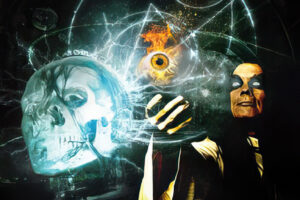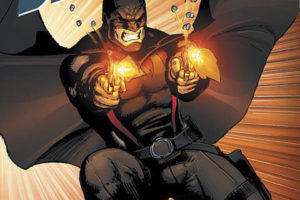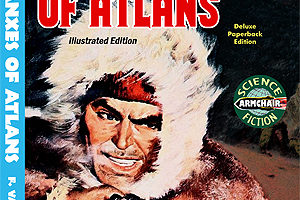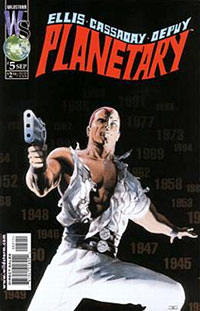 An interesting comic book series that made use of pulp and proto-pulp characters and themes is Planetary, by writer Warren Ellis and artist John Cassaday. This series ran 27 issues (plus some one-off additions) over 10 years (1999-2009) from DC/Wildstorm. You should still be able to get the collections of the comics.
An interesting comic book series that made use of pulp and proto-pulp characters and themes is Planetary, by writer Warren Ellis and artist John Cassaday. This series ran 27 issues (plus some one-off additions) over 10 years (1999-2009) from DC/Wildstorm. You should still be able to get the collections of the comics.
Set in the Wildstorm Universe, the underlying idea is that there is a “secret history” of the world, made up of the larger-than-life stories and characters we see in literature, comics, movies, and more. But the average person is totally unaware. Addressing this is the Planetary organization, which seeks out this secret history to preserve and record it, written up in annual Planetary Guides. Though it’s unclear how available these guides are, the Planetary organization has the resources to have multiple offices around the world.
In the first issue, we meet the field team, currently composed of Jakita Wagner and The Drummer. Each have superpowers. Jakita is strong, fast, and nearly invulnerable, while The Drummer can detect and affect information (not just that in computers and electronics, but whatever information is there around him). They have lost the third member of their team, Ambrose Chase, who could form a physics-distortion field. They work for the mysterious and unseen “Fourth Man” who runs Planetary (who he is a mystery in the early part of the series). They seek out Elijah Snow, who can subtract heat or basically make things freeze, to become a member of their team.
An interesting concept in the series is the idea of “Century Babies” — that some of those born on 1/1/1900 have exception abilities (and I guess also on 1/1/1800 and 1/1/2000, etc.). We soon learn that these people are actually part of the world’s “defense mechanism”, and their purpose is to save and preserve the world, similar to anti-bodies in our bodies. During the course of the series, we learn that several characters are Century Babies. Those who are descendants of these people also have exceptional abilities. We will learn that Snow is a Century Baby and Jakita is the descendant of one. I kind of felt that this was almost a take on the Wold Newton idea, except instead of a meteor, we have the world itself creating these exceptional people at the start of each century.
While it may seem the series would just be a sort of “travelogue,” with the Planetary team unearthing this secret history, we soon learn they are opposed by a group that is in many ways their opposite: The Four, who are an evil analogue of Marvel Comics’ Fantastic Four. Unlike Planetary, they destroy or hoard the secret history for their own sinister purposes, and eventually the Planetary group moves against them and hopefully defeats them.
In the series, pulp and proto-pulp characters play a role. So I thought I would focus on those for this posting. Other issues are inspired by several comic book genres, movie genres (such as Hong Kong cop movies, Japanese giant monsters, 50s sf movies, etc.), and much more.
Issue #1
In this issue, we meet, in flashbacks, a whole group of pulp hero analogues.
Toward the end of World War II, these heroes came together to try to help the world be a better place. To do so, they created a quantum computer to run through a wide range of possible outcomes. This computer actually created alternate Earths, and from one of these a group of Justice League of America analogues emerged to try to stop the pulp heroes. In the ensuing fight, all are killed but one of the pulp heroes, who now guards the computer until Planetary finds him and is able to help him turn off the computer.
The pulp hero analogues include:
- Doc Brass, a Doc Savage analogue and a Century Baby. Unlike Doc Savage, Brass is the product of a selective breeding program. He is the only survivor of the group, and we will see him further in the series.
- Hark, a Fu Manchu analogue who works to preserve China. His daughter, Anna Hark will appear in the series, and we will learn more about the Harks and their purpose.
- Edison, a Tom Swift analogue or an “Edisonade” as they are called, a youthful inventor/adventurer.
- Lord Blackstock, a Tarzan analogue. We will learn more about him in future issues.
- The “Shadowy Spider,” an analogue of both The Shadow and The Spider. Again, a character we will learn more about in future issues.
- The Aviator, a G-8 analogue. Your basic air war pulp hero.
- “Jimmy” the Agent, your basic Operator #5/secret agent pulp hero.
Issue #5
This issue focuses on Doc Brass, with a cover inspired by the Bantam Docs. We learn more about Doc Brass and his past adventures, including some with the other pulp heroes. We learn a little more about Anna Hark, and we learn how Doc was able to get Hark to join him in saving the world, by having him understand that China is part of the world, so by protecting the whole world he is also protecting China.
Issue #13
We learn that many of the exception people of the 19th century had joined together in a group to make the world a better place (sort of like Alan Moore‘s League of Extraordinary Gentlemen), but have gone bad. A young Elijah Snow decides to seek them out and put a stop to them. This group includes Sherlock Holmes, Dracula, Frankenstein and his Monster, the Invisible Man, H.G. Wells and maybe Jules Verne, Thomas Carnacki, John Carter, and maybe Robur the Conquer. At the end, we find out that Sherlock Holmes trains Snow, who then establishes Planetary and starts writing the Planetary Guides.
Issue #15
In an aside to the main story here, we learn of someone in the early 20th century named Carlton Marvell who wants to explore other worlds (like Edgar Rice Burroughs‘ Carson Napier), but who is dissuaded by Doc Brass and Edison from using spaceships. He instead decides to use the Australian Aborigines’ Dreamtime.
Issue #16
This issue focuses on Anna Hark. We learn she is of a long line of Harks, whose purpose is to ensure that “the sun will always come up” on China. We get a story of an ancient Hark who must fight an evil foe. We also find out that Anna knows she will live to be 300, and so has a longer view of time. In this story, Elijah Snow is able to get Anna Hark to join him in fighting the Four.
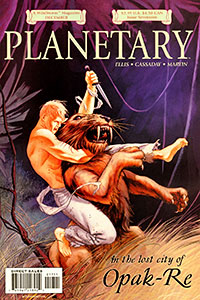 Issue #17
Issue #17
We get a look at the early life of Elijah Snow, with a cover inspired by the first pulp cover of Tarzan! This is because Elijah finds a super advanced city in Africa called Opak-Re, as well as meeting Lord Blackstock, whom we learn is also a Century Baby. And we learn that he is Jakita Wagner’s father!
Issue #18
In Jules Verne’s “From the Earth to the Moon,” the Baltimore Gun Club shot a projectile into space, which then returns. In this issue, the American Gun Club had done the same, but sadly their projectile is only now returning to Earth, over a century later.
Issue #22
With another pulp-inspired cover, this issue tells the story of Texas Ranger John Leather, who becomes the Dead Ranger, a much darker analogue to the Lone Ranger. He wears a mask of ashes, dark clothes, and rides an all-black steed. He uses silver bullets, but ones contaminated with mercury so even those wounded by them will suffer and die.
We then learn that he fathers the “Shadowy Spider”, who was born on 1/1/1900, yet another Century Baby! (How many of the pulp hero analogues are Century Babies?) This means that the Shadowy Spider is also a Green Hornet analogue, as well.
Well, as I said those are the main pulp-inspired elements in the series. I found the whole series really great and really imaginative. If you’ve never checked it out, please do so.

